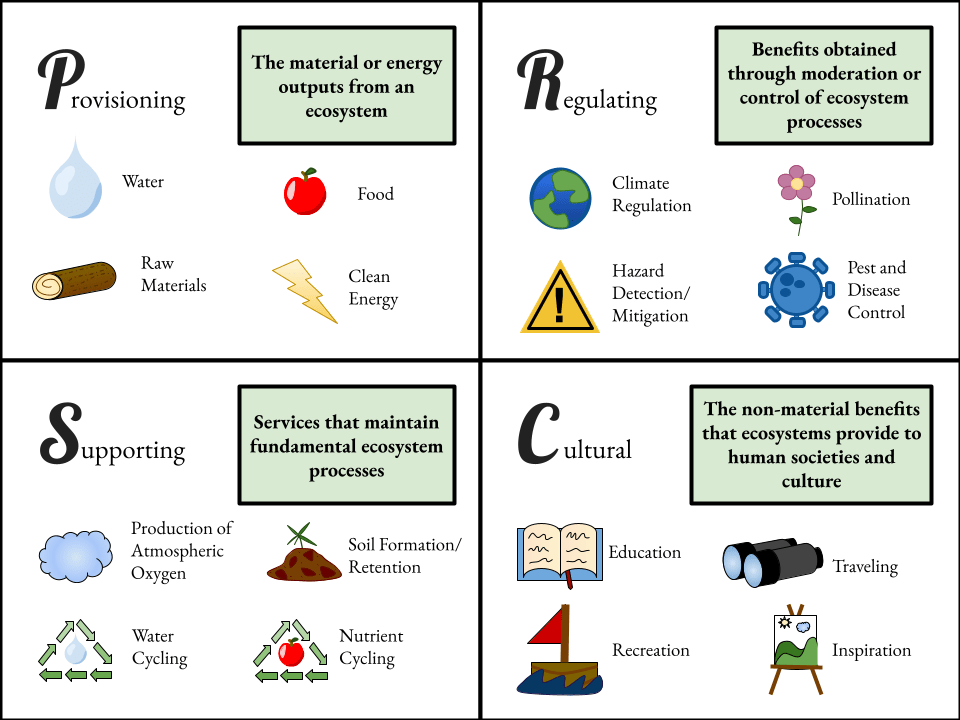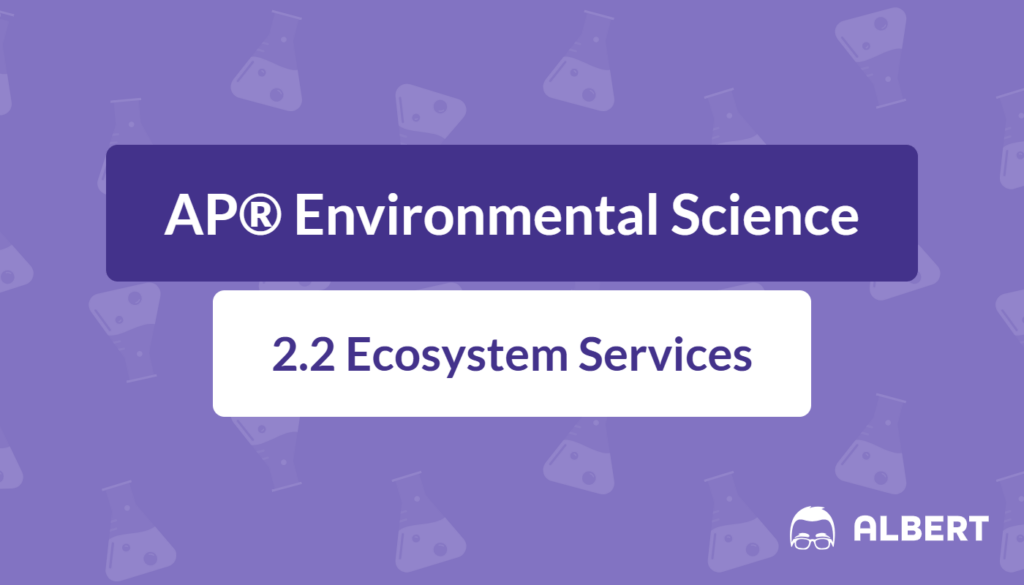What We Review
Introduction
Ecosystem services are benefits people gain from natural environments, including forests, wetlands, oceans, and grasslands. These services are vital for survival because they ensure the availability of clean air, fresh water, and nutritious food. Furthermore, they play a key role in stabilizing climate patterns and providing recreational and cultural value. By studying how ecosystems benefit societies, students of AP® Environmental Science gain a deeper understanding of conservation methods and sustainable practices.
However, human activities can disrupt these essential services. Therefore, it is important to explore the four categories of ecosystem services—provisioning, regulating, cultural, and supporting—and understand how they interact. This knowledge enables communities to better protect the environment and maintain the resources required for future generations.
What Are Ecosystem Services?
Ecosystem services are the processes and outputs that natural systems supply, benefiting human health, economies, and cultures. These services support agriculture, mitigate climate change, and provide spaces for spiritual and educational activities. For example, wetlands help filter pollutants and supply fresh water to nearby communities. In many regions, forests not only store carbon but also supply timber for construction and fuel.
Moreover, human well-being depends increasingly on protecting these services from anthropogenic activities, such as urban development and pollution. Whenever an ecosystem’s functionality is compromised, the benefits it provides also diminish. Consequently, it becomes critical to understand how these services operate to make sustainable decisions.
The Four Categories of Ecosystem Services
1. Provisioning Services
Provisioning services involve the tangible products that ecosystems generate. Examples include food (e.g., fish, crops), water, energy (e.g., biomass from forests), and raw materials like timber or plant fibers. These products form the building blocks for daily life. Next, they also contribute to the global economy by creating jobs in agriculture, fishing, and forestry.
Step-by-Step Example of Provisioning Services
Consider the concept of a sustainable fishery:
- A fish population can grow following a population growth model, such as the logistic growth equation.
- Assume a fish population (N) grows at a rate r until it reaches a habitat’s carrying capacity (K).
- The logistic growth can be expressed as G = rN \left(1 - \frac{N}{K}\right), where G is the growth of the population.
- The maximum sustainable yield (MSY) usually occurs near half the carrying capacity, at which point the population can be harvested without crashing.
- Through proper regulation and monitoring, fishers catch only up to the MSY, allowing the population to recover and continue providing food over time.
In this example, an ecosystem’s provisioning service (fish supply) remains reliable if it is managed sustainably. However, overfishing beyond the MSY can collapse the fish population, disrupting food supplies and the broader economy.
2. Regulating Services
Regulating services control natural processes to keep ecosystems balanced. Common examples include climate regulation, water purification, pollination, and disease management. Forests act as carbon “sinks,” storing carbon dioxide, which helps stabilize global temperatures and supports climate regulation. Wetlands absorb excess water during floods while also filtering pollutants from runoff.
Step-by-Step Example of Regulating Services
Take water purification through wetlands as an illustration:
- Water from a river or surrounding land flows into a wetland.
- Wetland plants and organisms break down and trap pollutants, such as fertilizers and sediments.
- Over time, cleaner water flows out of the wetland back into rivers or groundwater, maintaining water quality for downstream areas.
- This natural filtration reduces the need for costly water treatment facilities, which saves money and energy (often generated by renewable energy sources).
- However, if a wetland is drained for urban development, the regulating service vanishes, leading to pollution buildup in water systems.
Because wetlands provide a natural solution to water management and purification, their preservation is key to regulating water quality. Therefore, maintaining these services can reduce the stress on infrastructure and conserve resources for other environmental projects.
3. Cultural Services
Cultural services enrich the quality of life through non-material benefits derived from ecosystems. They can be recreational, spiritual, educational, or aesthetic in nature. National parks and forest reserves offer spaces for hiking, birdwatching, and spiritual reflection. Additionally, many communities attach religious or cultural significance to certain forests, rivers, or mountain areas.
Step-by-Step Example of Cultural Services
Imagine a protected coastal area that also contains coral reefs:
- The coral reefs attract tourists for snorkeling and diving.
- Tourism revenue supports local economies, funding community services and conservation efforts.
- Educational programs develop around the reefs, offering environmental science lessons.
- Visitors develop a deeper appreciation for marine ecosystems, inspiring further conservation actions.
- If coral reefs are damaged by pollution or climate change, these cultural services diminish, harming both the local economy and recreational opportunities.
Cultural services illustrate how ecosystems shape identities and societies. As a result, taking actions to maintain biodiversity and prevent damage to these environments also preserves cultural ties.
4. Supporting Services
Supporting services uphold the formation and maintenance of other ecosystem services. They include nutrient cycling, soil formation, photosynthesis, and the maintenance of biodiversity. These processes ensure that agriculture, forestry, and other human activities can persist long-term because they provide the essential biological foundation for ecosystems.
Step-by-Step Example of Supporting Services
Consider soil formation and nutrient cycling in a forest:
- Leaves and branches fall to the forest floor and decompose, adding organic matter to the soil.
- Nutrients such as nitrogen, phosphorous, and potassium are returned to the soil, where they become available to plant roots again.
- Soil organisms (bacteria, fungi, worms) assist in breaking down organic matter and improving soil structure.
- Healthy soils enhance plant growth and increase biodiversity, thus supporting wildlife and human needs.
- If deforestation removes or disrupts these supporting services, land may degrade, causing a decline in agricultural productivity.
When supporting services function effectively, all other ecosystem services can thrive. Therefore, preserving soil quality and nutrient cycles is vital for long-term environmental stability.

Human Disruptions to Ecosystem Services
Anthropogenic activities—those originated or influenced by humans—can reduce the ability of ecosystems to provide services. For instance, industrial agriculture often uses excessive fertilizers and pesticides, contaminating water supplies and harming beneficial pollinators. Urbanization, meanwhile, paves over natural habitats, which diminishes habitat for native species.
Therefore, disruptions to ecosystem services may have both economic and ecological effects. When pollinators decline, agricultural yields drop, driving up food prices. Similarly, removing forests leads to higher carbon dioxide levels and contributes to climate change. Yet, with careful planning and sustainable resource use, it is possible to reduce negative impacts.
Case Studies of Human Impact
- Overuse of Aquifers: In certain agricultural regions, aquifers are pumped unsustainably faster than they can recharge. Consequently, provisioning services (fresh water) become scarce, threatening crops and entire communities.
- Deforestation in the Amazon Rainforest: Large areas of forest are cleared for cattle ranching and monoculture crops, which disrupts climate regulation by releasing stored carbon. This process also degrades the cultural services of indigenous communities that rely on the forest’s biodiversity.
- Coral Reef Destruction: Various factors—such as rising sea temperatures (due to excess carbon emissions), destructive fishing practices, and pollution—destroy coral reefs. This disruption removes crucial regulating and cultural services, harming valuable habitats and local economies.
However, restoration and conservation efforts show promise. Reforestation projects help regain lost habitats, while sustainable fishing regulations restore fish populations. Protecting wetlands through legislation secures water purification services, decreasing the need for expensive water treatment. Additionally, renewable energy sources lower greenhouse gas emissions, ensuring that critical regulating services remain intact.
Conclusion
Ecosystem services underpin the survival and well‑being of human societies. Provisioning services supply vital goods, regulating services stabilize natural processes, cultural services enrich human experiences, and supporting services keep ecosystems running efficiently. Because anthropogenic activities often harm these services, efforts to preserve them are essential.
Understanding ecosystem services in AP Environmental Science encourages informed decision-making and responsible stewardship of Earth’s resources. Consequently, studying these services—and how to protect them—can guide communities toward sustainable practices. To continue exploring ecosystem services, students can investigate restoration case studies, participate in citizen science projects, or evaluate local conservation policies.
Important Vocabulary
- Ecosystem Services: Benefits, such as water filtration or food supply, that ecosystems provide to humans and the environment.
- Anthropogenic Activities: Human actions or processes, often contributing to environmental alterations or pollution.
- Maximum Sustainable Yield (MSY): The largest catch or harvest level possible that still allows a population, like fish, to replenish.
- Carrying Capacity (K): The maximum population size an environment can sustain indefinitely.
- Nutrient Cycling: The movement and exchange of nutrients, such as nitrogen and phosphorus, between the physical environment and living organisms.
By recognizing how ecosystem services operate, students of AP® Environmental Science can better appreciate the interconnectedness of natural systems. Moreover, developing strategies to protect these services helps sustain the well‑being of current and future populations.
Sharpen Your Skills for AP® Environmental Science
Are you preparing for the AP® Environmental Science test? We’ve got you covered! Try our review articles designed to help you confidently tackle real-world AP® Environmental Science problems. You’ll find everything you need to succeed, from quick tips to detailed strategies. Start exploring now!
- AP® Environmental Science: 1.9 Review
- AP® Environmental Science: 1.10 Review
- AP® Environmental Science: 1.11 Review
- AP® Environmental Science: 2.1 Review
Need help preparing for your AP® Environmental Science exam?
Albert has hundreds of AP® Environmental Science practice questions, free response, and full-length practice tests to try out.








